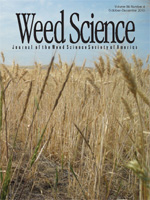Research was conducted to determine picloram and aminopyralid sorption in five soils and three clay minerals and to determine if the potential for off-target movement of aminopyralid in soil is less than that of picloram. Nearly all sorption of picloram and aminopyralid occurred between 0 and 8 h, and the maximum theoretical sorption of picloram and aminopyralid were 10.3 and 15.2%, respectively. Freundlich distribution coefficients (Kf) for picloram ranged from 0.12 in a Cecil sandy loam to 0.81 in an Arredondo fine sand, while Kf values for aminopyralid ranged from 0.35 in a Cecil sandy loam to 0.96 in an Arredondo fine sand. Furthermore, Kf values of aminopyralid were higher than those of picloram in all soils tested. Kf values of picloram in clay minerals were 0.25 (kaolinite), 1.17 (bentonite), and 1,016.4 (montmorillonite), and those of aminopyralid were 5.63 (kaolinite), 2.29 (bentonite), and 608.90 (montmorillonite). It was concluded that soil sorption of aminopyralid was greater than that of picloram and that the potential for off-target movement of aminopyralid is less than that of picloram.
Nomenclature: Aminopyralid; picloram.





